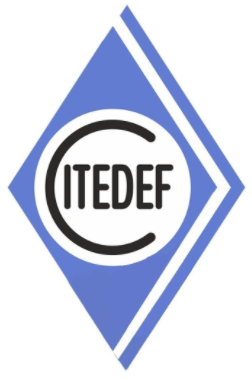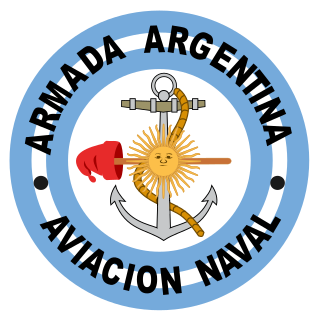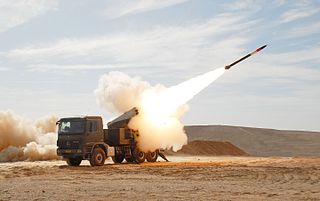
Rigel is an Argentinian sounding rocket. The double stage Rigel was launched seven times between 1969 and 1973. The Rigel rocket has a maximum altitude of 310 km, a launch mass of 300 kg, a diameter of 0.228 metres and a length of 6.30 metres.

Comisión Nacional de Actividades Espaciales is the civilian agency of the government of Argentina in charge of the national space programme.

El Arenosillo Test Centre (CEDEA) is the name of a rocket launch site for suborbital rockets managed by INTA, located near Mazagón in Spain. It is located in the province of Huelva, Andalucía, in the southwest coast of Spain (37.1° N, 6.7° W). CEDEA is adjacent to the Center of Excellence for Unmanned Systems (CEUS). El Arenosillo is also the location of an autonomous astronomical observatory of the BOOTES network, with two domes and three telescopes.

The Institute of Scientific and Technical Research for Defense, is an Argentine federal agency in charge of research and development in various scientific fields. It is also in charge of homologation of weaponry.

This comparison of orbital launch systems lists the attributes of all individual rocket configurations designed to reach orbit. A first list contains rockets that are operational or in development as of 2022; a second list includes all retired rockets. For the simple list of all conventional launcher families, see: Comparison of orbital launchers families. For the list of predominantly solid-fueled orbital launch systems, see: Comparison of solid-fueled orbital launch systems.

The Argentine Naval Aviation is the naval aviation branch of the Argentine Navy and one of its four operational commands. Argentina, along with Brazil is one of two South American countries to have operated two aircraft carriers

The Argentine defense industry has developed, over the years, different programs to improve the armed forces of Argentina. The first major steps to establish a defense industry were made during the Second World War and they received a boost during the 1970s after the United States imposed an arms embargo due to human rights violations. The politics of privatization carried out during the 1990s virtually eliminated domestic military production, but many factories were reopened during the last years.
Tronador is a series of Argentine rockets, including the Tronador I and Tronador II vehicles, to develop a liquid-propellant rocket expendable launch system called ISCUL.

A small-lift launch vehicle is a rocket orbital launch vehicle that is capable of lifting 2,000 kg (4,400 lb) or less or under 5,000 kilograms (11,000 lb) of payload into low Earth orbit (LEO). The next larger category consists of medium-lift launch vehicles.

Payload Aerospace S.L. is a Spanish company developing two partially-reusable launch vehicles called Miura 1 and Miura 5.

The National Police of Uruguay is a national and institutional police force of the Republic of Uruguay, founded on December 18, 1829. It depends on the Executive Power through the Ministry of the Interior. Its main mission is to protect the free exercise of rights and freedoms, guarantee order, internal security, ensure compliance with the laws, assist and protect people, prevent the commission of crimes, ensure security in public places and events, repress behaviors that constitute crimes and misdemeanors.

Lynx is a multiple rocket launcher developed and manufactured by Israel Military Industries (IMI) and used by Israel Defense Forces and other countries.
The National Commission for Aerospace Research and Development (CONIDA) (Spanish: Comisión Nacional de Investigación y Desarrollo Aeroespacial) is a national space agency tasked with government space activities in Peru.
Miura 5 is a two-stage European orbital recoverable launch vehicle of the Spanish company PLD Space currently under development. Miura 5 will be 24.9 m long, capable of inserting 900 kg of payload into a low Earth orbit (LEO), featuring an optional kick stage that can circularize the orbits of satellites. All stages are planned to be liquid-propelled. The launch vehicle was previously called Arion 2 but in 2018 PLD Space changed its name.

Gira 100 años contigo was the sixth concert tour by American group Ha*Ash in support of the act's fifth studio album, 30 de Febrero (2017). The tour began in Viña del Mar, Chile on February 24, 2018, and concluded in Puebla, Mexico on September 1, 2022. A live recording was released on 6 December 2019 under the title Ha*Ash: En Vivo.
El Hierro Launch Centre is a proposed project by Instituto Nacional de Técnica Aeroespacial (INTA) to create a spaceport on the island of El Hierro, part of the Canary Islands. It would be located in the south of the island, in the area of Tacorón, 5 km from La Restinga. in the municipality of El Pinar, Canary Islands. It is being proposed as a center of civil use exclusively, for the launch of micro- and nanosatellites with scientific or commercial objectives, such as telecommunications or Earth observation.
The INTA-100 vehicle was a small 2-stage meteorological sounding rocket designed and developed between the 1980s and the 1990s by the Instituto Nacional de Técnica Aeroespacial (INTA). The final design was entirely produced in Spain to be used by the Instituto Nacional de Meteorología in conducting experiments on the atmosphere.

TEPREL is a family of rocket engines designed and built by the Spanish aerospace company PLD Space for their Miura 1 and Miura 5 launch vehicles. The TEPREL engine, named after the Spanish reusable engine program that is financing its development, uses kerosene and liquid oxygen as propellants. So far, several versions of this engine, intended to propel Miura 1, have been developed and tested on the company's own liquid propulsion test facilities located in Teruel, Spain.













